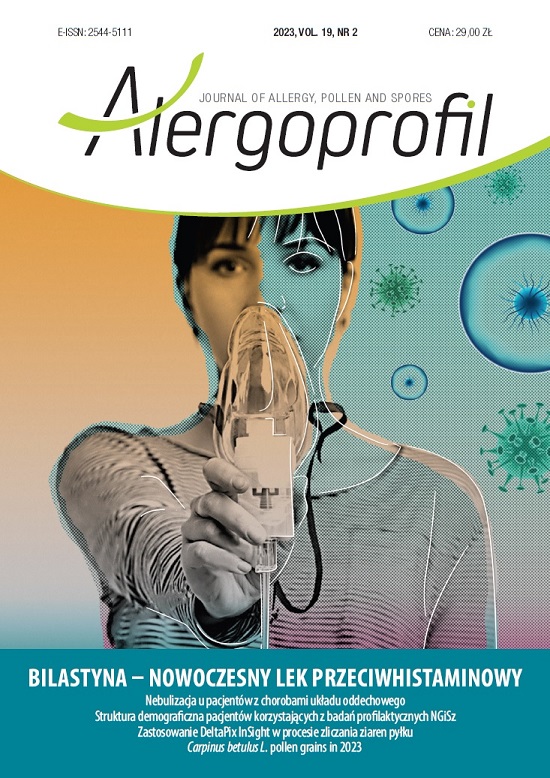Carpinus betulus L. pollen grains in the aeroplankton of twelve selected Polish cities in 2023 Original article
Main Article Content
Abstract
In Poland, Hornbeam (Carpinus betulus L.) is one of the trees responsible for the symptomes of spring allergy, although epidemiology of sensitivity is not well understood. The aim of this study was to analyse the Carpinus betulus L. pollen seasons in the following cities of Poland: Białystok, Bydgoszcz, Kraków, Kielce, Lublin, Łódź, Olsztyn, Opole, Piotrków Trybunalski, Szczecin, Warszawa i Zielona Góra.
Pollen grain was recorded with the standardized volumetric method with the Hirst type traps. The following parameters were included in the analysis: length of the season, peaks of pollen concentration and their date of occurrence, sezonal total values and the numer of days of the pollen concentration above the treshold value that could cause symptoms.
The Hronbeam pollen season in 2023 started in the third decade of March or the firts decade of April and lasted until May, for 33.58 days on average. The highest total values were recorded in Szczecin, Zielona Góra, Bydgoszcz, Kraków and Kielce, while the lowest in Bialystok and Lublin. Compared to 2014, the 2023 sesaon was generally charactarized by an earlier start, higher total daily and annual pollen levels.
Downloads
Article Details

This work is licensed under a Creative Commons Attribution-NonCommercial 4.0 International License.
Copyright: ? Medical Education sp. z o.o. This is an Open Access article distributed under the terms of the Attribution-NonCommercial 4.0 International (CC BY-NC 4.0). License (https://creativecommons.org/licenses/by-nc/4.0/), allowing third parties to copy and redistribute the material in any medium or format and to remix, transform, and build upon the material, provided the original work is properly cited and states its license.
Address reprint requests to: Medical Education, Marcin Kuźma (marcin.kuzma@mededu.pl)
References
2. Seneta W, Dolatowski J, Zieliński J. Dendrologia. Wyd. 5 rozszerzone. PWN, Warszawa 2022.
3. Sheng Q, Song M, Zhu Z et al. Physiological and biochemical responses of two precious Carpinus species to high-concentration NO2 stress and their natural recovery. Sci Rep. 2021; 11: 9500.
4. Brackx M, Van Wittenberghe S, Verhelst J et al. Hyperspectral leaf reflectance of Carpinus betulus L. saplings for urban air quality estimation. Environ Pollut. 2017; 220: 159-67.
5. Piechnik Ł. Carpinus betulus and occurrence of natural tree hollows in managed forests. Fragm Flor et Geobot Pol. 2020; XXVII(1): 33-43.
6. Zhou Q, Zhao F, Zhang H et al. Responses of the growth, photosynthetic characteristics, endogenous hormones and antioxidant activity of Carpinus betulus L. seedlings to different light intensities. Front Plant Sci. 2022; 13: 1055984.
7. Boratyński A. Carpinus betulus. In: Schuck HJ, Schütt P, Weisgerber H. Enzyklopädie der Laubbäume. Nikol, Hamburg 2006.
8. Csenge A, Felegyi-Tóth, Garádi Z et al. Isolation and quantification of diarylheptanoids from European hornbeam (Carpinus betulus L.) and HPLC-ESI-MS/MS characterization of its antioxidative phenolics. J Pharm Biomed Anal. 2022; 210: 114554.
9. Lee JS, Kim HJ, Park H et al. New diarylheptanoids from the stems of Carpinus cordata. J Nat Prod. 2002; 65: 1367-70.
10. Sheng Q, Fang X, Zhu Z et al. Seasonal variation of pheophorbide a and flavonoid in different organs of two Carpinus species and its correlation with immunosuppressive activity. Vitr Cell Dev Biol Anim. 2016; 52: 654-61.
11. WHO/IUIS Allergen Nomenclature Sub-Committee. Allergen nomenclature (access: 26.09.2023)
12. Alergome (access: 26.09.2023).
13. Dramburg S, Hilger C, Santos AF. EAACI Molecular Allergology User?s Guide 2.0. Pediatr Allergy Immunol. 2023; 34 (suppl. 28): e13854.
14. Mari A, Wallner M, Ferreira F. Fagales pollen sensitization in a birch-free area: a respiratory cohort survey using Fagales pollen extracts and birch recombinant allergens (rBet v 1, rBet v 2, rBet v 4). Clin Exp Allergy. 2003; 33: 1419-28.
15. Hofer F, Fischer AL, Kamenik AS et al. ph-dependent structural diversity of profilin allergens determines thermal stability. Front Allergy. 2022; 3: 1007000.
16. Wallner M, Erler A, Hauser M et al. Immunologic characterization of isoforms of Car b 1 and Que a 1, the major hornbeam and oak pollen allergens. Allergy. 2009; 64: 452-460.
17. Asam C, Hofer H, Wolf M et al. Tree pollen allergens-an update from a molecular perspective. Allergy. 2015; 70: 1201-11.
18. Chłopek K, Rapiejko P, Lipiec A et al. The analisis of hornbeam (Carpinus) pollen count in selected Polish cites in 2007. Allergprofil. 2007; 3: 39-44.
19. Lipiec A, Puc M, Kalinowska E et al. Pollen of hornbeam in the air of selected cites of Poland in 2014. Allergoprofil. 2014; 10: 48-55.
20. Polak D, Vollmann U, Grilo J et al. Bet v 1-independent sensitization to major allergens in Fagales pollen: Evidence at the T-cell level. Allergy. 2023; 78: 743-51.
21. Czekalski M. Drzewo roku 1995 ? grab pospolity cz. IV. Szkółkarstwo. 1995; 4: 30-1.
22. The CABI Encyclopedia of Forest Trees. CABI, 2013: 102.

